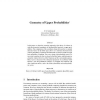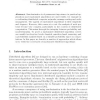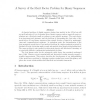115
click to vote
ISIPTA
2003
IEEE
15 years 6 months ago
2003
IEEE
We adopt the same mathematical model of a set M of probability measures as is central to the theory of coherent imprecise probability. However, we endow this model with an objecti...
100
click to vote
ISIPTA
2003
IEEE
15 years 6 months ago
2003
IEEE
In this paper we adopt the geometric approach to the theory of evidence to study the geometric counterparts of the plausibility functions, or upper probabilities. The computation ...
85
Voted
ISIPTA
2003
IEEE
15 years 6 months ago
2003
IEEE
In this paper we study two classes of imprecise previsions, which we termed convex and centered convex previsions, in the framework of Walley’s theory of imprecise previsions. W...
104
Voted
VOSS
2004
Springer
15 years 6 months ago
2004
Springer
We survey various notions of probabilistic automata and probabilistic bisimulation, accumulating in an expressiveness hierarchy of probabilistic system types. The aim of this paper...
VOSS
2004
Springer
15 years 6 months ago
2004
Springer
Abstract. Randomization is of paramount importance in practical applications and randomized algorithms are used widely, for example in co-ordinating distributed computer networks, ...
158
Voted
VOSS
2004
Springer
15 years 6 months ago
2004
Springer
Abstract. This paper describes symbolic techniques for the construction, representation and analysis of large, probabilistic systems. Symbolic approaches derive their efficiency by...
97
Voted
VOSS
2004
Springer
15 years 6 months ago
2004
Springer
Abstract. The paper presents a survey of out-of-core methods available for the analysis of large Markov chains on single workstations. First, we discuss the main sparse matrix stor...
SETA
2004
Springer
15 years 6 months ago
2004
Springer
Abstract. Merit factor of a binary sequence is reviewed, and constructions are described that appear to satisfy an asymptotic merit factor of 6.3421 . . . Multivariate merit factor...
116
Voted
SETA
2004
Springer
15 years 6 months ago
2004
Springer
We study algebraic feedback shift registers (AFSRs) based on quotients of polynomial rings in several variables over a finite field. These registers are natural generalizations o...
93
Voted
SETA
2004
Springer
15 years 6 months ago
2004
Springer
A classical problem of digital sequence design, first studied in the 1950s but still not well understood, is to determine those binary sequences whose aperiodic autocorrelations ...



